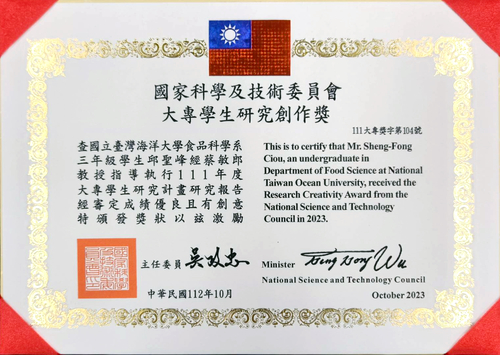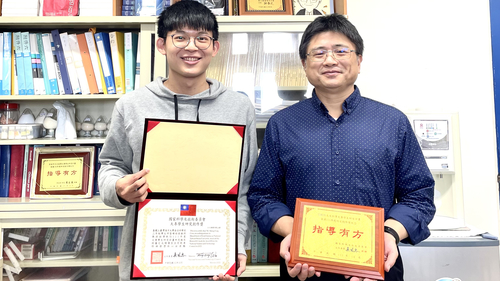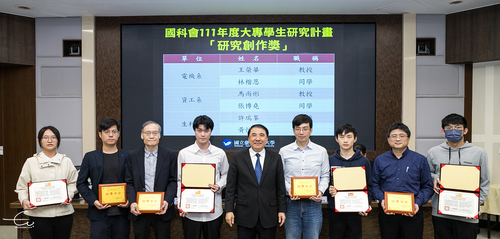邱聖峰同學(指導老師:蔡敏郎教授)榮獲111年度「國家科學及技術委員會大專學生研究創作獎」
學生姓名:邱聖峰
指導老師:蔡敏郎教授
論文題目:利用微生物法從蝦殼廢棄物製備胜肽鈣和幾丁質
Preparation of peptide chelated calcium and chitin from shrimp shell waste by using microbial method
蝦蟹甲殼類為臺灣重要的水產品,其產值約佔水產品的 10%,蝦類利用時約產生 50%的廢棄物,其中富含幾丁質和蛋白質。根據聯合國 17 項永續發展目標 中的綠色環保與永續發展,將這些生物資源進一步回收再利用有其必要性。本計 畫以綠色環保的微生物法和氣爆膨發法,發酵蝦殼廢棄物製備胜肽鈣和幾丁質, 並利用複合菌株連續發酵提升萃取效率;另外氣爆膨發經證實可將孔洞結構撐大 形成多孔化之物質,增加菌株發酵之表面積,進一步提升蝦蟹甲殼類去礦物質 (demineralization, DM)及去蛋白質(deproteinization, DP)效率,再分別收集發酵之 上清液產物(胜肽與鈣),進一步使胜肽與鈣離子螯合,最後測定胜肽鈣的螯合能 力及幾丁質之產率與基本物化性質。故本研究使用三種不同芽胞桿菌(Bacillus licheniformis、Bacillus subtilis、Bacillus mojavensis)發酵後再接入 Lactobacillus rhamnoides 之連續發酵方式,最後蝦殼粉(SP)與膨發蝦殼粉(ESP)之組別皆以 B. subtilis (BS)接入 L. rhamnoides (LR)有較好之 DM 效率(92.24%),而 B. licheniformis (BL)接入 L. rhamnoides 有較好之 DP 效率(93.49%);膨發後的蝦殼(ESP)影響結 晶度但不改變原有之鍵結型態,物化特性結果顯示 SP BSLR 與 ESP BSLR 之組 別在 DM 及 DP 效率上最好,接近化學法製備之幾丁質(CC)。胜肽與鈣根據不同 反應條件測試下,以 37°C、pH 8、加熱時間(90 分鐘)與質量比(1 : 1)之條件進行 反應,最終以 ESP BSLR 之組別有最好的螯合能力(72.80 mg/g),其次為 SP BSLR 之組別(70.75 mg/g)。
關鍵字:微生物法、氣爆膨發、蝦殼廢棄物、胜肽鈣、幾丁質
Shrimp and crab crustaceans are important aquatic products in Taiwan, and their output value accounts for about 10% of the aquatic products. Shrimp utilization produces about 50% waste, which is rich in chitin and protein. According to the green environmental protection and sustainable development in the 17 sustainable development goals of the United Nations, it is necessary to further recycle and reuse these bioresources. This study uses the green and environmentally friendly microbial method and explosion puffing method to ferment shrimp shell waste to prepare peptide chelated calcium and chitin, and uses successive fermentation of compound strains to improve the extraction efficiency. In addition, explosion puffing has been proven to expand the pore size and form a porous material, thus increasing the surface area of strain fermentation and further improve the demineralization (DM) and deproteinization (DP) efficiency of shrimp and crab crustaceans. The supernatant of the fermentation product is collected separately, chelating the peptide and calcium ions, and measure the ability of peptide chelating calcium, yield and basic physicochemical properties of chitin. Therefore, in this study, three different bacillus bacteria (Bacillus licheniformis, Bacillus subtilis, Bacillus mojavensis) were fermented and Lactobacillus rhamnoides (LR) was then added for the successive fermentation. For shrimp shell (SP) and explosive puffed shrimp shell (ESP), the group that B. subtilis (BS) was first added then later L. rhamnoides have better DM efficiency. While the group that B. licheniformis (BL) was first added then L. rhamnoides has better DP efficiency; the explosive puffed shrimp shell affects the crystallinity but does not change the original chemical bond structure. The results of physiochemical properties show that the group of SP BSLR and ESP BSLR have the best DM and DP efficiency, close to the chitin prepared by chemical method (CC). Peptide and calcium were tested under different reaction conditions. The reaction was carried out under the conditions of 37 °C, pH 8, heating time (90 min) and mass ratio (1:1). The result shows that the ESP BSLR group (72.80 mg/g) has the best chelating ability, followed by the SP BSLR group (70.75 mg/g) .
Keywords:microorganism、explosive puffing、shrimp shell waste、peptide chelated calcium、chitin


